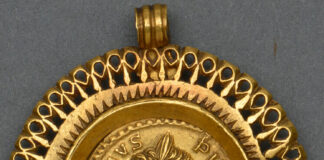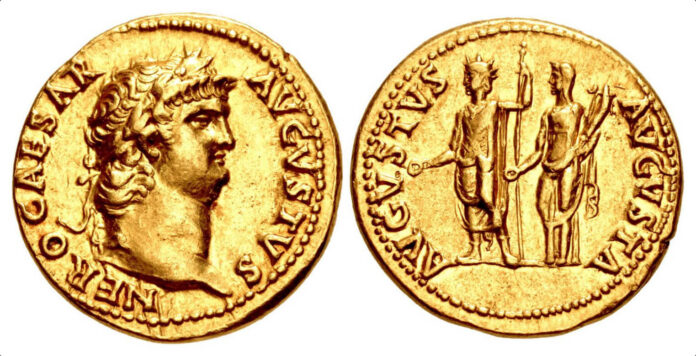
The 150 years straddling the turn of the first century BC to AD can accurately be called the Golden Age of the Roman Empire. For not only did Rome finish conquering the Mediterranean world and transition to a form of government that would endure for the next five centuries, it also introduced a coin that would come to symbolize wealth in the ancient world: the gold aureus.
The period between 49 BC and AD 96 also witnessed the reigns of the Twelve Caesars, a dozen strongmen whose lives and personalities were immortalized by the gossipy Roman biographer Suetonius in the second century AD, creating timeless archetypes for tyranny, wisdom, megalomania, and a host of other human qualities and foibles. His book has never been “out of print” in nearly 1,900 years. So, what could be more natural for a collector to desire to assemble a set of Rome’s first Twelve Caesars in the most powerful coin of the realm?
Here, then, is a rough guide to assembling a highly coveted Golden Set of the Twelve Caesars. It is not in any way comprehensive, but a quick survey of the emperors, the available coin types, and their prices. The main source book used here is The Roman Aurei by Xavier Calicó. Auction prices are sourced from CoinArchives.com Pro. All the gold aurei pictured in this article are featured Classical Numismatic Group’s Triton XXIV auction, set for January 19-20 2021 in Lancaster, PA, USA.
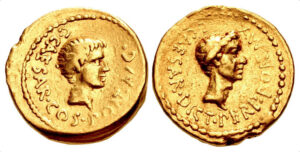
1. Gaius Julius Caesar (49-44 BC)
The first of the Twelve Caesars was born to an aristocratic but fairly impoverished family, the Julii, in 100 BC. He quickly grew into a young man of remarkable intelligence, military genius, and immense charm. He was also utterly unscrupulous and willing to lay waste to centuries worth of Republican tradition to establish himself as the uncontested ruler of Rome, which he achieved between 49 and 45 BC.
The first truly large Roman coinage in gold was struck by Caesar in 46 BC, the year he staged a magnificent triumphal parade in Rome to celebrate his decade-long conquest of Gaul and the hard-fought victories over his political enemies. First struck by the Dictator Sulla in circa 83 BC, but issued only sporadically and in small numbers thereafter, the gold aureus, so named for aurum, the Latin word for gold, weighed about eight grams and was valued 25 silver denarii. Since each of Ceasar’s triumphing soldiers was paid 5,000 denarii, this was likely paid out in the form of 200 aurei per man. The coins depict a rather mysterious veiled female head on the obverse, possibly the hearth goddess Vesta; on the reverse are the symbols of the Pontifex Maximus, a title Caesar also held.
These coins were struck in such huge numbers that they are still fairly common today, so if one is not fixated on obtaining an actual portrait of Caesar, a gold coin in his name can be easily obtained. As with all Roman coins, condition is key to price. A Hirtius-type Caesar aureus in VF condition, with a few flaws, can be had for $5,000 or less; examples in Superb condition have brought north of $30,000 at auction.
While Caesar placed his portrait on silver coins during his lifetime, his portrait gold aurei are all posthumous, struck in the years following his infamous assassination on March 15, 44 BC. The most widely available of these was struck in 43 BC by Caesar’s grand-nephew and heir, Octavian, depicting on opposite sides his own youthful head and the craggy, wrinkled effigy of his late uncle. There are likely fewer than 40 surviving examples of this type in any condition, so it is not surprising that they fetch extreme prices when offered at auction, with a superb specimen selling at auction for the equivalent of $565,000 in 2011.

2. Octavian / Augustus (44 BC-AD 14)
As Caesar’s heir, the precocious 18-year-old Gaius Julius Caesar Octavianus ultimately outwitted and defeated all rivals to become Caesar’s true successor and the first emperor of Rome. The Senate granted him the unprecedented title of Augustus in 27 BC, and he reigned as Rome’s sole ruler nearly five decades. By the time of his passing in AD 14, the concept of one-man ruler was firmly established and the names Caesar and Augustus became titles born by his successors.
Augustus regularized the Roman system of coinage, resulting in a fully realized set of denominations from the tiny copper quadrans up to the gold aureus. The aureus, worth 25 silver denarii and 100 brass sesterces, had immense buying power, in modern terms roughly equivalent to $500 (or 420 euros).
Augustus struck an immense number of gold aurei, at Rome and at cities throughout the Roman Empire. His refined, classically handsome features are remarkably consistent and show little sign of aging. More than 150 different reverse types are known, all part of a sophisticated propaganda machine touting his personal qualities, achievements, and relations. Some of the common reverse types depict his birth sign of Capricorn, a charging bull (symbolic of his ancestral birthplace of Thurium in southern Italy), and his two grandsons, Gaius and Lucius Caesar, both of whom predeceased him.
Though common as a whole, individual types of Augustus aurei can be extremely rare and/or of exceptional artistry, and fetch extraordinary prices exceeding $650,000 in high grade. In Fine to VF condition, the common Augustan types can be obtained for under $5,000.
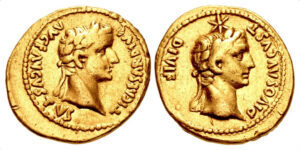
3. Tiberius (14-37)
The stepson and successor of Augustus, Tiberius Claudius Nero, was the son of his wife Livia by a previous marriage. A capable soldier, he had a dour personality and, already a tired man in his 50s, accepted the burden of state only with reluctance. In AD 26, Tiberius retired to a villa on the island of Capri, but his ambitious underling Sejanus made a mess of things in Rome, leading to his suppression and a bloodbath. Tiberius almost certainly knew nothing about the most momentous event of his reign, the crucifixion of Jesus Christ in far-off Judaea Province.
Deeply conservative, Tiberius struck only three gold aureus types throughout his 23-year reign. By far the most common reverse (in both gold and silver) depicts a seated female figure identified as his mother Livia as Pax, goddess of Peace. These aurei can be had in average grade for around $3,500 to $5,000; prices in superb condition top out in the mid-$20,000 range.
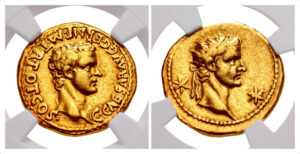
4. Gaius ‘Caligula’ (37-41)
A great-grandson of both Augustus and Mark Antony, Gaius Germanicus Caesar (nicknamed Caligula, or “little boot,” after his childhood footwear) had impeccable bloodlines, but, unfortunately for Rome, no talent for government. Becoming emperor at age 25, he was wildly popular at first, but a serious bout of illness in his first year seemed to unhinge his mind. His cruel and wildly over-the-top actions have become legend, but his reign of madness was mercifully brief, ending in assassination in January AD 41.
Reigning only three years and eight months, Caligula’s gold coinage is considerably rarer than that of the previous Caesars. For all his supposed insanity, his types are sedate, depicting his obverse portrait paired with his grandfather Augustus, his father Germanicus, and his mother Agrippina Senior. A still rarer variety depicts a wreath enclosing a legend.
A portrait of Caligula is a keystone coin in any Twelve Caesars aureus set and will set you back a considerable sum. A superb double-portrait aureus of Caligula and Divus Augustus recently sold for the equivalent of $300,000 at auction. A VF example will usually bring in excess of $25,000.
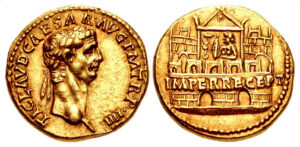
5. Claudius (41-54)
After Caligula’s murder, the Praetorian Guards elevated his scholarly uncle Claudius as emperor and forced a reluctant Senate to confirm their choice. A solitary bookworm with a host of nervous tics (today we would say he was “on the spectrum”), he had survived the murderous intrigues of his Julio-Claudian family by keeping a low profile. Once installed in power, he surprised everyone by ruling with competence and wisdom.
Claudius reigned 13 years and his aurei are relatively plentiful today. Events celebrated on reverses include his elevation by the Praetorians, his invasion and conquest of southern Britannia in AD 43, and his award of the Corona Civica (an oak wreath) for saving Rome from the tyranny of Caligula. After AD 50, his reverse types feature his new wife, Agrippina the Younger and her son Nero Claudius Caesar, whom Claudius adopted as his heir in AD 51.
Aurei of Claudius are readily obtainable and prices are determined more by condition than the rarity of any particular reverse type. The highest priced example on CoinArchives.com, which sold for $110,000 in 2008, was a relatively common Corona Civica type in extremely high grade. In Fine to VF condition, a Claudius aureus can be had for around $4,000 or somewhat less.
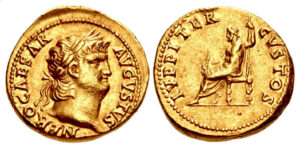
6. Nero (45-68)
Nero’s name has become synonymous with self-indulgence and megalomania, with good reason. But the first half of his reign was later viewed as a model of moderation and good government. His early gold aurei, up to AD 64, show remarkable deference to the Roman Senate, usually including the reverse legend S C (Senatus Consulto). In that year came the Great Fire of Rome, which destroyed much of the city and required a massive rebuilding program that strained the Empire’s finances. Nero was forced to reduce the weight of both the gold aureus and silver denarius, and his heavy taxation and property seizures caused his popularity to plummet. It was this crisis, more than his extravagance or artistic pretentions, that caused the collapse of his regime in AD 68.
Nero’s gold aurei are among the most common of the Twelve Caesars. His progress from a chubby youth to a bloated, dissipated adult can be followed on his coin portraits. The earliest of his gold issues depict his portrait paired with that of his formidable mother, Agrippina, whom he had murdered in AD 58. One of these rare double-portrait issues holds the record auction price for a Nero aureus, selling for $140,000 in 2018. At the low end, a Nero aureus in VF condition will usually sell for a little north or south of $2,000.
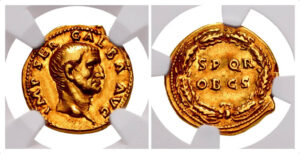
7. Galba (68-69)
The overthrow of Nero left no heirs of the Julio-Claudian line and quickly led to a free-for-all by Roman generals, the Year of the Four Emperors. The first of these was Servius Sulpicius Galba, the wizened and respectable governor of Spain. Once installed in power, his strict economy measures quickly alienated most of Roman society, including the one faction he could not afford to displease: the Praetorian Guard. These pampered troopers ambushed him in the Roman Forum on January 15 AD 69, cutting off his reign (and his head) at only six months.
In addition to the main mint at Rome, Galba’s gold was struck at mints in Spain and Gaul. The portraits are frequently outstanding, showing him as a craggy, scowling aristocrat. His aurei are rare, though perhaps not so rare as one might expect for so brief a reign (the same could be said for all the ephemeral emperors of AD 68-69). The record hammer price of $390,000 was set at an auction in 2008; a specimen in VF condition will still usually run $7,500 or more.
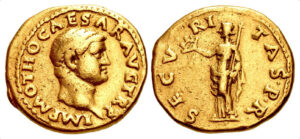
8. Otho (AD 69)
Next in the imperial carousel came Marcus Salvius Otho, a playboy aristocrat and former drinking buddy of Nero’s who bribed the Praetorians to eliminate Galba. His rule was immediately threatened by a revolt of the legions in Roman Germany in favor of their governor, Vitellius. A short, sharp Civil War went against him and Otho opened his veins after a reign of only 99 days, briefest of the Twelve Caesars.
Otho paid his bribe to the Praetorians in the form of thousands of gold aurei bearing his smooth-faced effigy. His hair is suspiciously helmet-like, and Suetonius confirms this is a wig worn over a shaved head, as Otho abhorred body hair. Another key coin in the set, Otho aurei are offered infrequently at auction and most are heavily worn, with examples grading Fine still reaching prices of $10,000 or more. CoinArchives.com lists the record auction price for an Otho aureus at $260,000, set for a Choice EF specimen from the Huntington Collection in 2012.
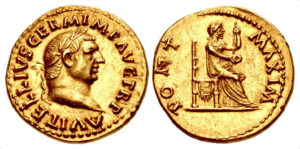
9. Vitellius (AD 69)
After his victory over Otho, Aulus Vitellius made his way to Rome at the head of his army in a procession more like a drunken bacchanalia than a military parade. His seven months as emperor were one orgy of decadence that put even Nero to shame, all of which further drained the state coffers. A revolt by Vespasian, general in Judaea, put an end to Vitellius in December 69 and probably saved the Roman Empire from complete dissolution.
Like Galba, Vitellius struck aurei in Spain and Gaul as well as Rome, each mint with its own distinctive portrait style and reverses. All depict Vitellius as grossly obese, the antithesis of the refined Augustus. The record price of $296,000 was set in a 2007 auction for a beautifully toned example; a VF example will likely bring $7,500 to $10,000 or more, depending on the portrait quality or reverse type.
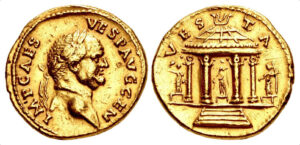
10. Vespasian (69-79)
A tough soldier from a middle-class background, Vespasian established the Flavian dynasty and brought Rome a much-needed respite of orderly rule. He put the Empire’s finances on a sound footing and reigned with prudence and moderation, aided by his capable son, Titus.
Gold aurei of Vespasian are plentiful, struck at several mints besides Rome, and bear a variety of interesting historical reverse types. Among the most popular are those related to the Jewish War, a five-year uprising in Judea against Roman rule ultimately crushed by Titus in AD 70. The record price of $338,000 for a Vespasian aureus was set in 2016 for a IVDAEA DEVICTA (“Judea Is Conquered”) type depicting a bound Jewish captive by a palm tree. A VF (worn but pleasing) aureus of Vespasian with a common reverse type can be obtained for $1,500 to $3,000.
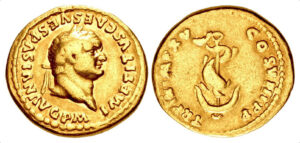
11. Titus (79-81)
Titus Flavius Vespasianus smoothly succeeded his father and was generally popular during his brief reign, despite the eruption of Vesuvius in AD 79 that buried Pompeii. His time as emperor also witnessed the completion of the Colosseum in Rome and the extravagant games to mark its opening.
Aurei of Titus were struck during the decade he served as Caesar (heir-apparent) to his father, in addition to his two years as Augustus. The types continue those of Vespasian, with a few innovations. Although his coins are relatively common and similarly priced to those of Vespasian, a Titus aureus holds the auction record for any gold coin of the Twelve Caesars: $800,000 for an extremely rare IVDAEA DIVICTA issue, achieved at a New York auction in 2012.
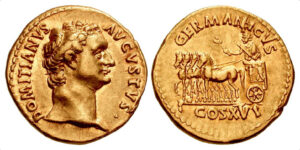
12. Domitian (81-96)
Last of the Twelve Caesars, Titus Flavius Domitianus was the younger brother of Titus who finally got his chance to rule after a sudden illness claimed his elder sibling in September, AD 81. Like Tiberius, Domitian was of a dour personality and had a tough act to follow, but was not without ability. He finally grew paranoid in his later years and a full-fledged reign of terror was ended only by his assassination on 18 September AD 96.
Gold aurei of Domitian as Caesar were struck by Vespasian and Titus, depicting him as full-faced with rather rustic features in common with his fellow Flavians. Once he became Augustus, his coins adopted a slimmed-down and more idealized effigy. His reverse types usually depict his patron goddess Minerva. The record price for a Domitian aureus of $109,000 was set in 2013 by rare type from the Huntington Collection. A more common type in VF can be obtained in the $3,000 to $5,000 range.
And if you want to browse the aurei of the Twelve Caesars, you can do that directly in CNG’s Triton auction catalogue.
Have a look if some of the Twelve Caesars are among the most expensive Roman gold coins!



